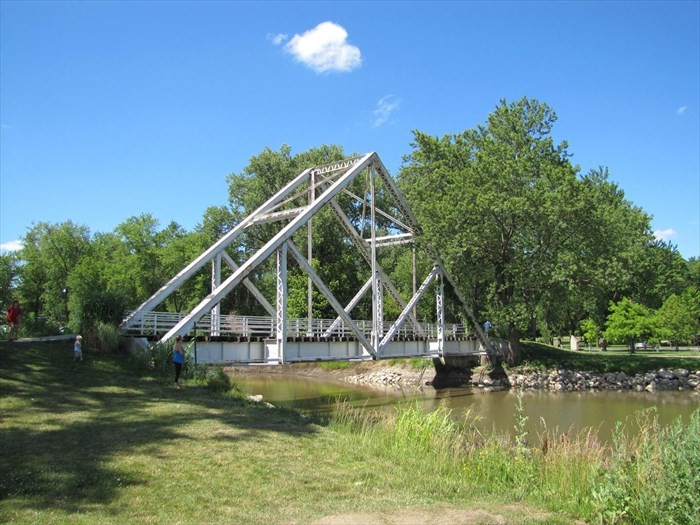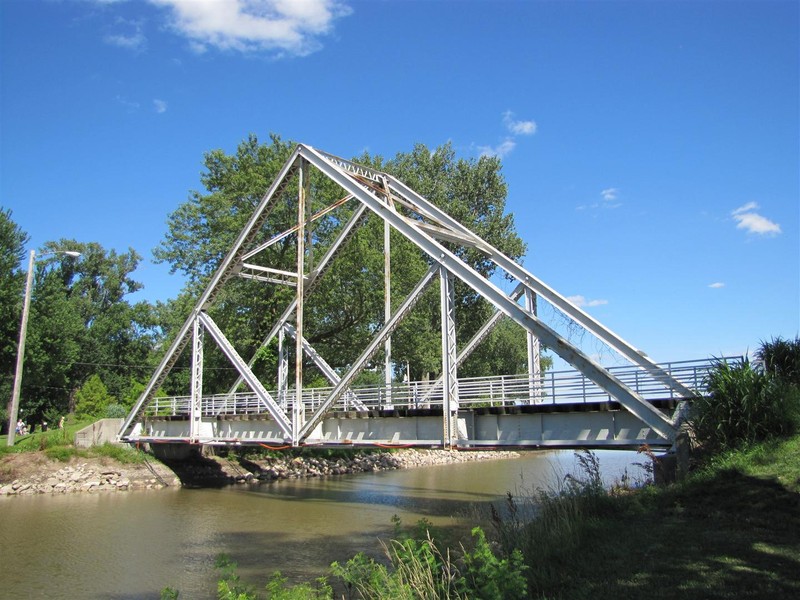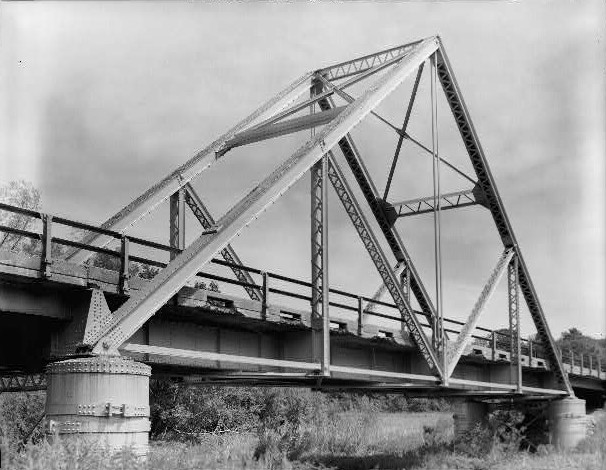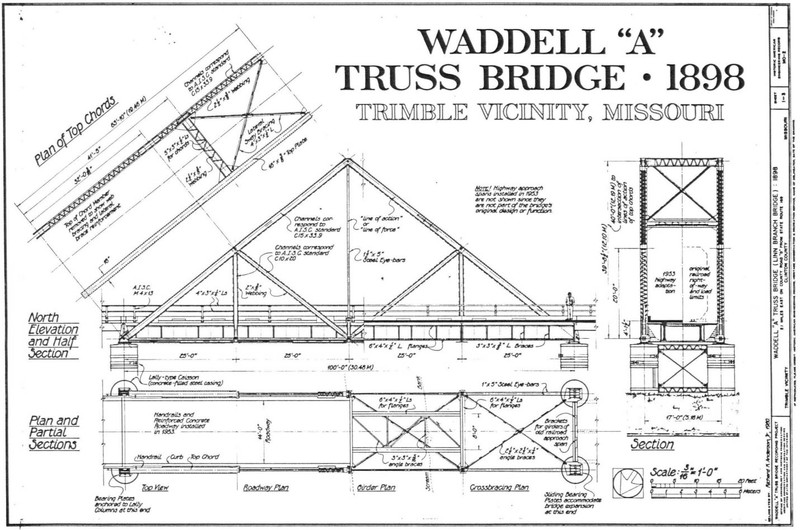Waddell "A" Truss Bridge in Parkville, Missouri
Introduction
Text-to-speech Audio
One of only two "A" truss bridges still standing in the U.S., Parkville's Waddell "A" Truss Bridge was constructed in 1898 as the Linn Branch Creek Bridge for the Quincy, Omaha, and Kansas City Railway. Now serving pedestrians, the bridge was converted from a railroad to a highway bridge in the 1950s and then moved in the 1980s to English Landing Park. The bridge is architecturally significant for a variety of reasons, including its connection to John Alexander Low Waddell, a master bridge builder who enjoyed an international reputation as a teacher of engineering. Wadell was also a practicing professional engineer and an author who designed Chicago's Elevated ("el") Train, California's Atlantic and Pacific Railway Bridge (1890) across the Colorado River, and the 1893 Missouri River Railroad Bridge in East Omaha. Wadell also designed bridges in Japan, Canada, Mexico, Russia, China, and New Zealand.
Images
Waddell "A" Truss Bridge - Parkville, Missouri

Waddell "A" Truss Bridge - Parkville, Missouri

The original Waddell "A" Truss Bridge, Spanning Lin Branch Creek, Trimble vicinity, Clinton County, MO.

Waddell's design for the "A" Truss Bridge

Backstory and Context
Text-to-speech Audio
Canadian native John Alexander Low Waddell (1854-1938) studied in Ottawa, Canada, before receiving his Civil Engineering degree in 1875 from New York's Rensselaer Polytechnic Institute. He later received his Masters (1882) and Ph.D. (1908) in Engineering from McGill University in Montreal. In between his academic pursuits, he worked for the Canadian Pacific Railroad (1876-77), Chief Engineer for Raymond and Campbell Bridge Builders of Council Bluffs, Iowa (1880-1882), as a professor of civil engineering at the Imperial University of Tokyo. For his service in Japan, the Emperor awarded him the Knight's Cross of the Order of the Rising Sun in 1885. He returned to the U.S. in 1886 and subsequently established a practice in Kansas City, Missouri, as a bridge designer and consultant, where he evolved into one of the nation's most lauded bridge engineers for nearly a half-century.
During his fifty years of engineering, Waddell occasionally formed business partnerships, but his reputation soared as one of the world's leading bridge builders and engineers. In addition to bridges in the United States and Japan, Waddell also designed bridges in Canada, Mexico, Russia, China, and New Zealand. In the U.S., he built several significant railway bridges, including bridges across the Colorado River, Missouri River, and Chicago River. Indeed, his South Halsted Street Bridge over the Chicago River stood as the nation's first long-span, vertical-lift bridge. Also, in Chicago, Waddell served as the consulting engineer on the construction of the city's infamous Elevated Railroad System (the "el").
In Missouri, notably in the Kansas City area, Waddell built several functional and decorative bridges. He also developed materials for use in large-span bridges, pioneering the use of nickel steel in girders subject to heavy stresses. Waddell also wrote several books, starting with The Designing of Ordinary Iron Highway Bridges (1884), where he heavily criticized the practice of low-bid, non-standardized bridge construction in the United States. His second book, A System of Iron Railroad Bridges for Japan (1885), ostensibly led to the Waddell "A" Truss Bridge design.
Waddell developed his "A" truss bridge to meet the need for a reliable, easily-erected, inexpensive, short-span railroad bridge. The "A" comes from the two, high main trusses connected by top bracing, which gave the bridge its characteristic "A" shape. Functionally, the design addressed the stress and vibration problems intrinsic to the more commonly used pony truss forms (Waddell recommended against pony trusses in A System of Iron Railroad Bridges for Japan) around the turn of the twentieth century. Waddell developed the method in Japan, where it was widely used, but then he perfected it in the United States.
The historic Waddell "A" truss bridge in Parkville sat originally in Trimble, Missouri when it opened in 1898 as the Linn Branch Creek Bridge. The bridge carried the Quincy, Omaha, and Kansas City Railroad until 1939. The bridge received a facelift in 1952 and transitioned into a segment of State Route 4, which remained its purpose for nearly twenty-five years. However, when the U.S. Army Corp built the Sraithville Dam, the bridge had to be removed. In 1987, the Linn Branch Creek Bridge was relocated and reassembled and relocated in Parkville, Missouri.
The Waddell "A" truss is generally regarded as a transitional phase in bridge design as rapid technological advancements quickly rendered the "A" truss obsolete. By 1916, Waddell himself pronounced the "A" truss design "antiquated." But the demise of the "A" truss did not spell the end for Waddell, who continued to head bridge projects, publish books and journals, and give lectures on engineering throughout the first three decades of the twentieth century. Waddell also received honorary degrees from several U.S. universities and the Imperial University of Japan.
Sources
Hauck, George F. W. "Registration Form: Waddell "A" Truss Bridge." National Register of Historic Places. mostateparks.com. 1990. https://mostateparks.com/sites/mostateparks/files/Waddell%20A%20Truss%20Bridge.pdf.
Jackson, Donald. C. "Historic American Engineering Record." National Park Service. loc.gov. Specific date unknown (written between 1953 and 1987). https://tile.loc.gov/storage-services/master/pnp/habshaer/mo/mo0100/mo0162/data/mo0162data.pdf.
Nyman, William E., "Dr. J.A.L. Waddell's Contributions to Vertical Lift Bridge Design." Heavy Movable Structures, Inc. Ninth Biennial Symposium: Preserving Traditional Values with New Technologies. October 22-25, 2002. https://heavymovablestructures.org/wp-content/uploads/2017/12/0092.pdf.
https://www.waymarking.com/waymarks/WMB7C8_Waddell_A_Truss_Bridge_Parkville_Missouri
https://www.waymarking.com/waymarks/WMB7C8_Waddell_A_Truss_Bridge_Parkville_Missouri
By Image taken by unknown photographer - This image is available from the United States Library of Congress's Prints and Photographs divisionunder the digital ID hhh.mo0162.This tag does not indicate the copyright status of the attached work. A normal copyright tag is still required. See Commons:Licensing for more information., Public Domain, https://commons.wikimedia.org/w/index.php?curid=1863687
By Historic American Engineering Record - HAER - Waddell "A" Truss Survey (1980)https://www.loc.gov/pictures/collection/hh/item/mo0162/, Public Domain, https://commons.wikimedia.org/w/index.php?curid=106314238
